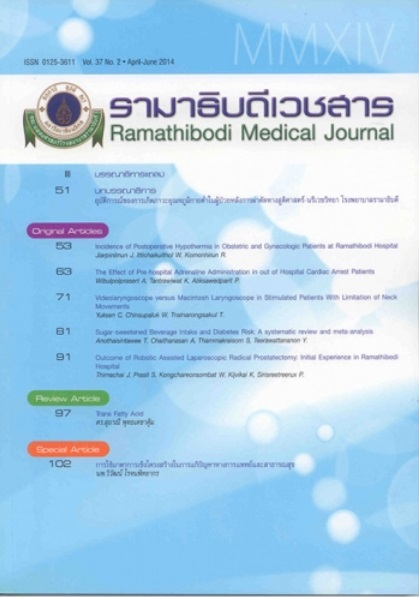Videolaryngoscope versus Macintosh Laryngoscope in Stimulated Patients With Limitation of Neck Movements
Main Article Content
Abstract
Background: Endotracheal intubation in patients with suspect cervical spine injury must be done with carefulness because it could cause injury to the cervical spine. Modern equipment are used to help intubation, especially for patients who suspect cervical spine injury.
Objective: To compare the Glidescope video laryngoscope (GVL) with the Macintosh laryngoscope (ML) in manikin with cervical collars.
Methods: 2 groups of participants (Emergency resident: experienced in intubation and 5th year medical students : inexperience in intubation) were randomized to intubate by Glidescope video laryngoscope (GVL) and Macintosh laryngoscope (ML) on a manikin wearing a cervical collar. The time required to intubate, the success rate, the number of intubation attemps and Cormack-Lehane classification (CL) were recorded.
Results: The mean time to intubation was significantly shorter with ML than with GVL especially in experienced group. But for inexperienced group, time to intubation was not different. There was no difference in the success rate of tracheal intubation between GVL and ML. The view of the glottis (CL) was significantly better with the GVL than with the ML especially in inexperienced medical student.
Conclusions: GVL provided better laryngeal view than ML, but it look an additional 6 seconds for tracheal intubation. It had potential advantages over ML for difficult intubation especially in inexperienced medical student. But it had a longer time to intubation.
Article Details
References
American College of Surgeons. Advanced trauma life support for doctors ATLS student course manual. Eighth edition. Chicago: Am C Surg. 2008;7:26-37.
Chiu WC, Haan JM, Cushing BM, Kramer ME, Scalea TM. Ligamentous injuries of the cervical spine in unreliable blunt trauma patients: incidence, evaluation, and outcome. J Trauma. 2001;50(3):457-463.
Maruyama K, Yamada T, Kawakami R, Hara K. Randomized cross-over comparison of cervical-spine motion with the AirWay Scope or Macintosh laryngoscope with in-line stabilization: a video-fluoroscopic study. Br J Anaesth. 2008;101(4):563-567. doi:10.1093/bja/aen207.
Phillips S, Celenza A. Comparison of the Pentax AWS videolaryngoscope with the Macintosh laryngoscope in simulated difficult airway intubations by emergency physicians. Am J Emerg Med. 2011;29(8):863-867. doi:10.1016/j.ajem.2010.03.024.
Enomoto Y, Asai T, Arai T, Kamishima K, Okuda Y. Pentax-AWS, a new videolaryngoscope, is more effective than the Macintosh laryngoscope for tracheal intubation in patients with restricted neck movements: a randomized comparative study. Br J Anaesth. 2008;100(4):544-548. doi:10.1093/bja/aen002.
Su YC, Chen CC, Lee YK, Lee JY, Lin KJ. Comparison of video laryngoscopes with direct laryngoscopy for tracheal intubation: a meta-analysis of randomised trials. Eur J Anaesthesiol. 2011;28(11):788-795. doi:10.1097/EJA.0b013e32834a34f3.
Kim HJ, Chung SP, Park IC, Cho J, Lee HS, Park YS. Comparison of the GlideScope video laryngoscope and Macintosh laryngoscope in simulated tracheal intubation scenarios. Emerg Med J. 2008;25(5):279-282. doi:10.1136/emj.2007.052803.
Choi GS, Lee EH, Lim CS, Yoon SH. A comparative study on the usefulness of the Glidescope or Macintosh laryngoscope when intubating normal airways. Korean J Anesthesiol. 2011;60(5):339-343. doi:10.4097/kjae.2011.60.5.339.
Aoi Y, Inagawa G, Nakamura K, Sato H, Kariya T, Goto T. Airway scope versus macintosh laryngoscope in patients with simulated limitation of neck movements. J Trauma. 2010;69(4):838-842. doi:10.1097/TA.0b013e3181c4529e.
Platts-Mills TF, Campagne D, Chinnock B, Snowden B, Glickman LT, Hendey GW. A comparison of GlideScope video laryngoscopy versus direct laryngoscopy intubation in the emergency department. Acad Emerg Med. 2009;16(9):866-871. doi:10.1111/j.1553-2712.2009.00492.x.
Hirabayashi Y, Seo N. Tracheal intubation by non-anaesthetist physicians using the Airway Scope. Emerg Med J. 2007;24(8):572-573.
Park SO, Shin DH, Lee KR, Hong DY, Kim EJ, Baek KJ. Efficacy of the Disposcope endoscope, a new video laryngoscope, for endotracheal intubation in patients with cervical spine immobilisation by semirigid neck collar: comparison with the Macintosh laryngoscope using a simulation study on a manikin. Emerg Med J. 2013;30(4):270-274. doi:10.1136/emermed-2011-200899.
Kim JK, Kim JA, Kim CS, Ahn HJ, Yang MK, Choi SJ. Comparison of tracheal intubation with the Airway Scope or Clarus Video System in patients with cervical collars. Anaesthesia. 2011;66(8):694-698. doi:10.1111/j.1365-2044.2011.06762.x.
Komatsu R, Kamata K, Sessler DI, Ozaki M. A comparison of the Airway Scope and McCoy laryngoscope in patients with simulated restricted neck mobility. Anaesthesia. 2010;65(6):564-568. doi:10.1111/j.1365-2044.2010.06334.x.
Hastings RH, Wood PR. Head extension and laryngeal view during laryngoscopy with cervical spine stabilization maneuvers. Anesthesiology. 1994;80(4):825-831.
Greenland KB, Eley V, Edwards MJ, Allen P, Irwin MG. The origins of the sniffing position and the Three Axes Alignment Theory for direct laryngoscopy. Anaesth Intensive Care. 2008;36 Suppl 1:23-27.
Levitan RM, Ochroch EA, Kush S, Shofer FS, Hollander JE. Assessment of airway visualization: validation of the percentage of glottic opening (POGO) scale. Acad Emerg Med. 1998;5(9):919-923.
Sun DA, Warriner CB, Parsons DG, Klein R, Umedaly HS, Moult M. The GlideScope Video Laryngoscope: randomized clinical trial in 200 patients. Br J Anaesth. 2005;94(3):381-384.
